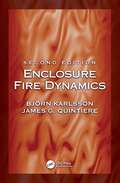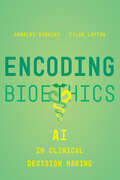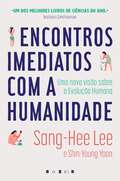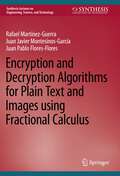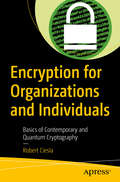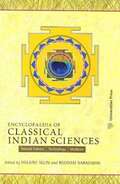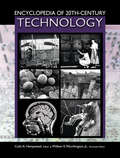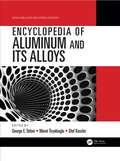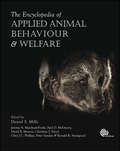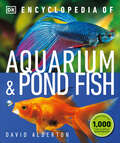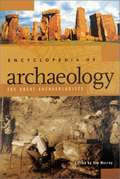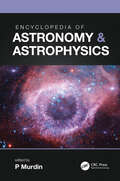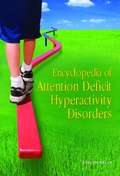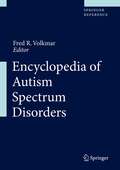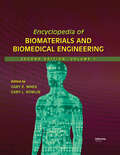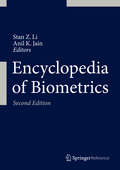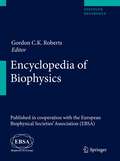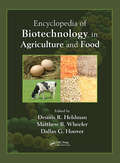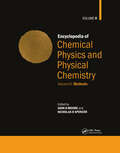- Table View
- List View
Enclosure Fire Dynamics, Second Edition
by James G. Quintiere Björn KarlssonEnclosure Fire Dynamics, Second Edition explores the science of enclosure fires and how they cause changes in the environment of a building on fire. The authors discuss mechanisms controlling enclosure fires and how to develop analytical relationships useful in designing buildings for fire safety. Derivation of equations from first principles is shown, stating assumptions and showing comparisons to experimental data, giving calculated examples for clarity. The text provides readers with the skills needed to solve a range of engineering equations and problems. Features include: Describes the outbreak of compartment fires and the mechanisms controlling them Derives simple analytical relationships from first principles and shows how to compare the derived equations with experimental data, giving calculated examples for clarity. Provides the calculational procedures and describes computer models needed to design a building for safety Cites the most up-to-date standards and references throughout Includes numerous chapter problems to test student readers’ understanding of fire behavior Enclosure Fire Dynamics, Second Edition will enhance the knowledge of fire protection engineers, researchers, and investigators and help build a strong foundation for engineering students.
Encoding Bioethics: AI in Clinical Decision-Making
by Charles Binkley Tyler LoftusEncoding Bioethics addresses important ethical concerns from the perspective of each of the stakeholders who will develop, deploy, and use artificial intelligence systems to support clinical decisions. Utilizing an applied ethical model of patient-centered care, this book considers the viewpoints of programmers, health system and health insurance leaders, clinicians, and patients when AI is used in clinical decision-making. The authors build on their respective experiences as a surgeon-bioethicist and a surgeon–AI developer to give the reader an accessible account of the relevant ethical considerations raised when AI systems are introduced into the physician-patient relationship.
Encolhi meu melhor amigo! Ooops! Livro 1 (Encolhi meu melhor amigo! #1)
by Katrina Kahler John Zakour Daiana K. NeumannEu encolhi meu melhor amigo! - Ooops! Livro 1: Livros para meninas de 9 a 12 anos escrito por Katrina Kahler e John Zakour. Bella e seu melhor amigo Joe, são duas crianças muito inteligentes que passam cada minuto livre juntos. Um dia, eles elaboram um plano, um plano que os tornará super ricos e super famosos. É um plano tão bom que eles poderão deixar a escola e até ter seu próprio programa de TV! O que poderia ser melhor que isso? No entanto, o plano não acontece Bella e Joe esperavam, e eles se vêem diante de um enorme problema; um que eles são incapazes de resolver por conta própria. Então, quando a paixão secreta de Bella na escola se envolve, as coisas começam a ficar ainda mais interessantes. Este é um livro muito engraçado do começo ao fim, e irá mantê-la rindo, bem como tentar adivinhar o que acontecerá a seguir. Um ótimo livro para meninas e também um ótimo livro para meninos. Na verdade, é uma história fabulosa para quem gosta de livros engraçados. Perfeito para crianças de 9 a 12 anos, esta história vai mantê-lo entretido desde o início! Gênero: FICÇÃO JUVENIL / Quadrinhos e Romances Gráficos / Geral Gênero Secundário: FICÇÃO JUVENIL/ Ciência e tecnologia
Encontros Imediatos com a Humanidade: Uma Nova Visão Sobre a Evolução Humana
by Sang-Hee Lee Shin-Young YoonUma nova visão sobre a Evolução Humana. De onde viemos, como vivemos ou porque temos esta aparência são algumas das questões fundamentais que nos ocorrem nalgum ponto das nossas vidas. Uma nova visão sobre a Evolução Humana De onde viemos, como vivemos ou porque temos esta aparência são algumas das questões fundamentais que nos ocorrem nalgum ponto das nossas vidas. A evolução humana é um campo em constante mudança, não havendo, por isso, respostas certas nem perguntas erradas. Neste livro fascinante, Sang-Hee Lee explora e questiona alguns dos pressupostos evolutivos a partir de novos e inesperados ângulos. A agricultura foi um passo em falso na evolução humana? Porque é o parto tão difícil para as mulheres? Porque é que os humanos adultos bebem leite? O que temos em comum com os neandertais? As histórias presentes neste livro oferecem uma nova perspetiva sobre os primeiros hominíneos, desafiando as perceções sobre a progressão tradicional da evolução. Combinando uma visão antropológica com investigação inovadora, as surpreendentes conclusões da autora lançam uma nova luz sobre os primórdiosda humanidade. À medida que avançamos na evolução, Lee ajuda-nos a determinar para onde caminhamos e aborda uma das questões científicas mais urgentes: será que a humanidade continua a evoluir? Os elogios da crítica: «Um dos melhores livros de ciências do ano.» -Instituto Smithsonian «De forma sucinta e cativante, Lee revisita as principais questões sobre a história da evolução da nossa espécie.» - Nature «Uma nova visão sobre a nossa singularidade.» - New Scientist
Encouraging Foreign Direct Investment: The key factors for long-term investment sustainability (SpringerBriefs in Energy)
by Tareq MahbubThis book identifies and investigates the determinants that influence investment decision-making for conducting foreign direct investment (FDI) in Bangladesh’s power sector. This book is organized around six core themes. These are: Bangladesh’s vision to become a middle-income country by 2021 and have universal power for all; an overview of the benefits and costs of FDI from a host nation’s perspective; an outlook of Bangladesh’s power sector starting from the years 1994-2008 through 2011-2015 to 2016-2020 and beyond; the key factors that encourage foreign investors to conduct FDI in the Bangladeshi power sector subsumed under four broad categories of investment prospects namely, regulatory, economic and financial, political and social; the key barriers that deter FDI in the Bangladeshi power sector; and policy implications for long-term investment sustainability in the power sector.The main arguments posited in this book are: regulatory aspects are the most important for firms when conducting FDI in the power sector; land acquisition is a perineal problem that continues to hamper the development of large-scale power projects; there is a need for a transparent and competitive selection process to improve transparency and accountability in private power procurement; and more exploration of onshore and offshore gas fields with the extension of gas transmission networks be enhanced that ensure a regional balance of primary energy supply (gas) for setting up additional gas-based power plants in the country.
Encryption and Decryption Algorithms for Plain Text and Images using Fractional Calculus (Synthesis Lectures on Engineering, Science, and Technology)
by Rafael Martínez-Guerra Juan Javier Montesinos-García Juan Pablo Flores-FloresThis book offers an alternative for encrypting and decrypting messages using objects called integer and fractional-order estimators or observers, by means of security codes. The authors first establish the class of observers capable of carrying out this work. Then, the type of observers to treat either the integer or fractional order type and their main characteristics is mentioned. The book also presents an essential property of some systems such as Liouville, which is vital for the encryption and decryption of messages in integer and fractional order nonlinear systems by using the synchronization property of chaotic systems. Finally, it addresses some logistic maps such as Mandelbrot sets including Julia and fractal sets, taking advantage of their characteristics to encrypt or recover messages.
Encryption for Organizations and Individuals: Basics of Contemporary and Quantum Cryptography
by Robert CieslaCryptography and encryption aren't just for geeks and spies—they’re also part of our daily lives. This book enlightens you with the basics of digital cryptography and covers the must-do practices organizations need to implement when it comes to fending off data theft and eavesdroppers. You will uncover the concepts of digital encryption and examine key digital encryption algorithms and their various applications. Gauging cryptography from an enterprise perspective, you will get an in-depth look at common attacks that can occur in your systems and lean how to counter themMoving on to quantum computing, you will discover how it differs from the current computing paradigm and understand its potential for the future. After clearing the basics, you will take a close look at how quantum computers work in practice. Shifting focus to quantum cryptography, you will learn more about quantum key distribution (QKD) and how it differs from present-day encryption methodologies. You will also consider the current implementations of QKD, including distribution systems by SwissQuantum and QKD-distribution networks provided by the DARPA Quantum Network. Ultimately, you will learn the means of defending against cryptographic attacks in the up-and-coming quantum age, such as utilizing zero-knowledge proof (ZKP) systems.Deepen your knowledge of cryptographic concepts and be introduced to the new paradigm of quantum cryptography with this book. What You Will LearnAppreciate how digital encryption algorithms workSecure your infrastructure from cryptographic attacksUnderstand the basics of quantum information scienceDiscover how cryptography relates to quantum computingImplement Quantum Key Distribution (QKD) Who This Book Is ForThis book is aimed at readers who have an interest in both well-established and up-and-coming types of cryptography, as well as members of organizations to whom privacy is a top priority.
Encyclopaedia of Classical Indian Sciences
by Helaine Selin Roddam NarasimhaThis book is an attempt to provide an authentic account of natural science, technology and medicine as practiced by Indians and other South Asians. It also includes biographical articles on ancient Indian scientists.
Encyclopedia of 20th-Century Technology
by Colin A. HempsteadComprised of 395 essays arranged alphabetically, most on individual objects, artifacts, techniques, and products, this is an up-to-date reference work for all those involved in teaching or researching the history of twentieth-century technology, as well as the serious general reader. The core of each of the main entries is a technical description, within a historical narrative, of about 1,000 words plus illustrations and further reading. There are also about 30 longer survey entries that that address broad questions of technological systems, such as the context in which the various technologies were developed, discussions of any controversies and schools of thought, comparisons between different political and economics systems, and the various ways in which different nations have attempted to make and apply science and technology policies.
Encyclopedia of Agricultural, Food, and Biological Engineering
by Dennis R. Heldman Carmen I. MoraruThe Definitive Reference for Food Scientists & EngineersThe Second Edition of the Encyclopedia of Agricultural, Food, and Biological Engineering focuses on the processes used to produce raw agricultural materials and convert the raw materials into consumer products for distribution. It provides an improved understanding of the processes used in
Encyclopedia of Aluminum and Its Alloys, Two-Volume Set (Metals and Alloys Encyclopedia Collection)
by George E. Totten Murat Tiryakioglu Olaf KesslerThis encyclopedia, written by authoritative experts under the guidance of an international panel of key researchers from academia, national laboratories, and industry, is a comprehensive reference covering all major aspects of metallurgical science and engineering of aluminum and its alloys. Topics covered include extractive metallurgy, powder metallurgy (including processing), physical metallurgy, production engineering, corrosion engineering, thermal processing (processes such as metalworking and welding, heat treatment, rolling, casting, hot and cold forming), surface engineering and structure such as crystallography and metallography.
Encyclopedia of Applied Animal Behaviour and Welfare
by David Morton Peter Sandøe Jeremy Marchant-Forde Clive Phillips Christine Nicol Paul Mcgreevy Daniel Mills Ronald SwaisgoodWelfare research has established a range of scientific indicators of stress, welfare and suffering in animals that can be applied to all aspects of improving their welfare through good housing and management, and the topic continues to grow in importance among both professionals and the public. The practical focus of this authoritative, comprehensive encyclopedia aims to promote the understanding and improvement of animals' behaviour without compromising welfare. Under the editorial direction of Professor Daniel Mills, the UK's first specialist in veterinary behavioural medicine, over 180 international experts have contributed a wealth of fully cross-referenced entries from concise definitions to detailed short essays on biological, practical, clinical and ethical aspects of behaviour and welfare in domestic, exotic, companion and zoo animals.
Encyclopedia of Aquarium and Pond Fish (DK Pet Encyclopedias)
by David AldertonThe most complete owner's manual for keeping all types of freshwater and saltwater fish in indoor tropical and coldwater aquariums and outdoor ponds.Choose the right fish for any water temperature--tropical or coldwater--and for all types of environments, including indoor aquariums or outdoor ponds. Know the difference between keeping saltwater fish and freshwater fish, including differences in aquarium setups, and feeding and caring for your pet fish. Learn to tell whether your fish are healthy and find out everything you need to breed them successfully. The Encyclopedia of Aquarium and Pond Fish contains a huge photographic color reference directory of more than 800 of the most popular fish, not only showing you what they look like, but also giving you key information you need, such as how big they will grow, whether they integrate with different fish, what food they eat, and what water type and temperature they prefer.
Encyclopedia of Aquatic Ecotoxicology
by Christian Blaise Jean-Francois FérardWith its 104 chapters, this Encyclopedia of aquatic ecotoxicology reveals the diversity of issues, problems and challenges that have faced, and are facing today, receiving environments. It also indicates ways by which tools, strategies and future investigations can contribute to correct, minimize, solve and prevent water quality degradation. Structured homogeneously, the chapters convey salient information on historical background, features, characteristics, uses and/or applications of treated topics, often complemented by illustrations and case studies, as well as by conclusions and prospects. This work is most suitable for teaching purposes. Academics, for example, could literally deliver comprehensive lectures to students simply based on chapter outlines and contents. Meet the Authors of the Encyclopedia! Check out 'Meet the Authors' under ADDITIONAL INFORMATION (Right menu).
Encyclopedia of Archaeology, Volume 1: The Great Archaeologists
by Tim MurrayThis two-volume set contains 58 biographies that constitute a history of archaeology from its beginnings in Renaissance antiquarianism, to the present day. Arranged chronologically, each entry contains a brief summary of the individual's importance and a discussion of the life and contributions of the person (with a focus on his or her role in the development of archaeology as a discipline), and a bibliography.
Encyclopedia of Astronomy & Astrophysics
by Paul MurdinIn a unique collaboration, Nature Publishing Group and Institute of Physics Publishing have published the most extensive and comprehensive reference work in astronomy and astrophysics. This unique resource covers the entire field of astronomy and astrophysics and this online version includes the full text of over 2,750 articles, plus sophisticated search and retrieval functionality and links to the primary literature. The Encyclopaedia's authority is assured by editorial and advisory boards drawn from the world's foremost astronomers and astrophysicists. This first class resource is an essential source of information for undergraduates, graduate students, researchers and seasoned professionals, as well as for committed amateurs, librarians and lay people wishing to consult the definitive astronomy and astrophysics reference work.
Encyclopedia of Attention Deficit Hyperactivity Disorders
by Evelyn B. KellyScience writer Kelly provides information on the controversial family of disorders for high school and college students, parents, teachers, and other non-specialists. She is not pushing a particular theory or approach, but sets out arguments and claims proffered by proponents of them. Medical information is referenced to researchers and Web sites. A sampling of topics shows the anticonvulsive medication carbamezepine, physician and writer Heinrich Hoffman, industrial and environmental toxins, and teaching children with ADHD. Entry-specific lists for further reading refer to the bibliography. There is little cross-referencing. Annotation c2009 Book News, Inc., Portland, OR (booknews.com)
Encyclopedia of Autism Spectrum Disorders
by Fred R. VolkmarThis major reference work breaks new ground as an electronic resource for students, educators, researchers, and professionals. Comprehensive in breath and textbook in depth, the Encyclopedia of Autism Spectrum Disorders serves as a reference repository of knowledge in the field as well as a regularly updated conduit of new knowledge long before such information trickles down from research to standard textbooks. The Encyclopedia consists of 5 volumes and approximately 1,500 entries divided by the major conceptual areas of ASD and PDDs, including: - Research trends and findings - Behavior/speech - Communication - Treatments - Education Taking advantage of the techniques offered by the electronic medium, the Encyclopedia of Autism Spectrum Disorders offers an extensive cross-referencing system facilitating search and retrieval of information.
Encyclopedia of Biomaterials and Biomedical Engineering
by Gary L. Bowlin Gary E. WnekWritten by more than 400 subject experts representing diverse academic and applied domains, this multidisciplinary resource surveys the vanguard of biomaterials and biomedical engineering technologies utilizing biomaterials that lead to quality-of-life improvements. Building on traditional engineering principles, it serves to bridge advances in materials science, life sciences, nanotechnology, and cell biology to innovations in solving medical problems with applications in tissue engineering, prosthetics, drug delivery, biosensors, and medical devices. In nearly 300 entries, this four-volume Encyclopedia of Biomaterials and Biomedical Engineering, Second Edition, covers: essential topics integral to tissue engineering research: bioreactors, scaffolding materials and fabrication, tissue mechanics, cellular interaction, and development of major tissues and organs being attempted by researchers worldwide; artificial lungs and muscles, bio-artificial livers, and corneal, dental, inner ear, and total hip implants; tissue engineering of blood vessels, heart valves, ligaments, microvascular networks, skeletal muscle, and skin; bone remodeling, bone cement, and bioabsorbable bone plates and screws; controlled drug delivery, insulin delivery, and transdermal and ocular implant-based drug delivery; endovascular stent grafts, vascular grafts, and xenografts; 3-D medical imaging, electrical impedance imaging, and intravascular ultrasound; biomedical, protein adsorption, and in vivo cardiovascular modeling; polymer foams, biofunctional and conductive polymers, and electroactive polymeric materials; blood–material interactions, the bone–implant interface, host reactions, and foreign body responses and much more.
Encyclopedia of Biometrics
by Stan Z. Li Anil K. JainThis encyclopedia provides a comprehensive reference to topics in biometrics including concepts, modalities, algorithms, devices, systems, security, performance testing, applications and standardization. With an A-Z format and over 1400 entries, it provides easy access to relevant information on all aspects of biometrics for those seeking entry into this broad field. Entries are written by experts in biometrics and related fields. Each entry includes a definition, key words, list of synonyms, list of related entries, illustration(s), applications and a bibliography. Most entries include useful literature references providing the reader with a portal to more detailed information. Comprehensive and tutorial, the Encyclopedia of Biometrics, 2nd Edition is a practical resource for experts in the field and professionals interested in aspects of biometrics.
Encyclopedia of Biophysics
by Gordon Roberts European Biophysical Societies' AssociationThe Encyclopedia of Biophysics is envisioned both as an easily accessible source of information and as an introductory guide to the scientific literature. It includes entries describing both Techniques and Systems. In the Techniques entries, each of the wide range of methods which fall under the heading of Biophysics are explained in detail, together with the value and the limitations of the information each provides. Techniques covered range from diffraction (X-ray, electron and neutron) through a wide range of spectroscopic methods (X-ray, optical, EPR, NMR) to imaging (from electron microscopy to live cell imaging and MRI), as well as computational and simulation approaches. In the Systems entries, biophysical approaches to specific biological systems or problems - from protein and nucleic acid structure to membranes, ion channels and receptors - are described. These sections, which place emphasis on the integration of the different techniques, therefore provide an inroad into Biophysics from a biological more than from a technique-oriented physical/chemical perspective. Thus the Encyclopedia is intended to provide a resource both for biophysicists interested in methods beyond those used in their immediate sub-discipline and for those readers who are approaching biophysics from either a physical or biological background.
Encyclopedia of Biotechnology in Agriculture and Food
by Dennis R. Heldman, Matthew B. Wheeler and Dallas G. HooverThe Encyclopedia of Biotechnology in Agriculture and Food provides users with unprecedented access to nearly 200 entries that cover the entire food system, describing the concepts and processes that are used in the production of raw agricultural materials and food product manufacturing. So that users can locate the information they need quickly without having to flip through pages and pages of content, the encyclopedia avoids unnecessary complication by presenting information in short, accessible overviews. Addresses Environmental Issues & Sustainability in the Context of 21st Century Challenges Edited by a respected team of biotechnology experts, this unrivaled resource includes descriptions and interpretations of molecular biology research, including topics on the science associated with the cloning of animals, the genetic modification of plants, and the enhanced quality of foods. It discusses current and future applications of molecular biology, with contributions on disease resistance in animals, drought-resistant plants, and improved health of consumers via nutritionally enhanced foods. Uses Illustrations to Communicate Essential Concepts & Visually Enhance the Text This one-of-a-kind periodical examines regulation associated with biotechnology applications—with specific attention to genetically modified organisms—regulation differences in various countries, and biotechnology’s impact on the evolution of new applications. The encyclopedia also looks at how biotechnology is covered in the media, as well as the biotechnology/environment interface and consumer acceptance of the products of biotechnology. Rounding out its solid coverage, the encyclopedia discusses the benefits and concerns about biotechnology in the context of risk assessment, food security, and genetic diversity. ALSO AVAILABLE ONLINE This Taylor & Francis encyclopedia is also available through online subscription, offering a variety of extra benefits for both researchers, students, and librarians, including: Citation tracking and alerts Active reference linking Saved searches and marked lists HTML and PDF format options For more information, visit Taylor & Francis Online or contact us to inquire about subscription options and print/online combination packages. US: (Tel) 1.888.318.2367 / (E-mail) e-reference@taylorandfrancis.com International: (Tel) +44 (0) 20 7017 6062 / (E-mail) online.sales@tandf.co.uk Dennis R. Heldman speaks about his work on the CRC Press YouTube Channel.
Encyclopedia of Chemical Physics and Physical Chemistry: Volume 1: Fundamentals
by John H Moore Nicholas D SpencerThe Encyclopedia of Physical Chemistry and Chemical Physics introduces possibly unfamiliar areas, explains important experimental and computational techniques, and describes modern endeavors. The encyclopedia quickly provides the basics, defines the scope of each subdiscipline, and indicates where to go for a more complete and detailed explanation. Particular attention has been paid to symbols and abbreviations to make this a user-friendly encyclopedia. Care has been taken to ensure that the reading level is suitable for the trained chemist or physicist. The encyclopedia is divided in three major sections: FUNDAMENTALS: the mechanics of atoms and molecules and their interactions, the macroscopic and statistical description of systems at equilibrium, and the basic ways of treating reacting systems. The contributions in this section assume a somewhat less sophisticated audience than the two subsequent sections. At least a portion of each article inevitably covers material that might also be found in a modern, undergraduate physical chemistry text. METHODS: the instrumentation and fundamental theory employed in the major spectroscopic techniques, the experimental means for characterizing materials, the instrumentation and basic theory employed in the study of chemical kinetics, and the computational techniques used to predict the static and dynamic properties of materials. APPLICATIONS: specific topics of current interest and intensive research.For the practicing physicist or chemist, this encyclopedia is the place to start when confronted with a new problem or when the techniques of an unfamiliar area might be exploited. For a graduate student in chemistry or physics, the encyclopedia gives a synopsis of the basics and an overview of the range of activities in which physical principles are applied to chemical problems. It will lead any of these groups to the salient points of a new field as rapidly as possible and gives pointers as to where to read about the topic in more detail.
Encyclopedia of Chemical Physics and Physical Chemistry: Volume 2: Methods
by John H Moore Nicholas D SpencerThe Encyclopedia of Physical Chemistry and Chemical Physics introduces possibly unfamiliar areas, explains important experimental and computational techniques, and describes modern endeavors. The encyclopedia quickly provides the basics, defines the scope of each subdiscipline, and indicates where to go for a more complete and detailed explanation. Particular attention has been paid to symbols and abbreviations to make this a user-friendly encyclopedia. Care has been taken to ensure that the reading level is suitable for the trained chemist or physicist. The encyclopedia is divided in three major sections: FUNDAMENTALS: the mechanics of atoms and molecules and their interactions, the macroscopic and statistical description of systems at equilibrium, and the basic ways of treating reacting systems. The contributions in this section assume a somewhat less sophisticated audience than the two subsequent sections. At least a portion of each article inevitably covers material that might also be found in a modern, undergraduate physical chemistry text. METHODS: the instrumentation and fundamental theory employed in the major spectroscopic techniques, the experimental means for characterizing materials, the instrumentation and basic theory employed in the study of chemical kinetics, and the computational techniques used to predict the static and dynamic properties of materials. APPLICATIONS: specific topics of current interest and intensive research.For the practicing physicist or chemist, this encyclopedia is the place to start when confronted with a new problem or when the techniques of an unfamiliar area might be exploited. For a graduate student in chemistry or physics, the encyclopedia gives a synopsis of the basics and an overview of the range of activities in which physical principles are applied to chemical problems. It will lead any of these groups to the salient points of a new field as rapidly as possible and gives pointers as to where to read about the topic in more detail.
Encyclopedia of Chemical Physics and Physical Chemistry: Volume 3: Applications
by John H Moore Nicholas D SpencerThe Encyclopedia of Physical Chemistry and Chemical Physics introduces possibly unfamiliar areas, explains important experimental and computational techniques, and describes modern endeavors. The encyclopedia quickly provides the basics, defines the scope of each subdiscipline, and indicates where to go for a more complete and detailed explanation. Particular attention has been paid to symbols and abbreviations to make this a user-friendly encyclopedia. Care has been taken to ensure that the reading level is suitable for the trained chemist or physicist. The encyclopedia is divided in three major sections: FUNDAMENTALS: the mechanics of atoms and molecules and their interactions, the macroscopic and statistical description of systems at equilibrium, and the basic ways of treating reacting systems. The contributions in this section assume a somewhat less sophisticated audience than the two subsequent sections. At least a portion of each article inevitably covers material that might also be found in a modern, undergraduate physical chemistry text. METHODS: the instrumentation and fundamental theory employed in the major spectroscopic techniques, the experimental means for characterizing materials, the instrumentation and basic theory employed in the study of chemical kinetics, and the computational techniques used to predict the static and dynamic properties of materials. APPLICATIONS: specific topics of current interest and intensive research.For the practicing physicist or chemist, this encyclopedia is the place to start when confronted with a new problem or when the techniques of an unfamiliar area might be exploited. For a graduate student in chemistry or physics, the encyclopedia gives a synopsis of the basics and an overview of the range of activities in which physical principles are applied to chemical problems. It will lead any of these groups to the salient points of a new field as rapidly as possible and gives pointers as to where to read about the topic in more detail.
